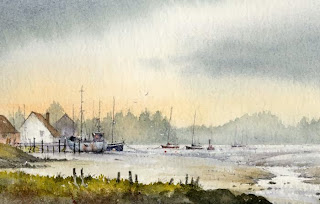The last six weeks have been a breathless dash and blogging I’m afraid has consequently suffered. The Patchings Art Festival in early June was marvellous as usual and it was good to see some of you there. It is always so well organised and seems to get better every year thanks to Chas Wood and his enthusiastic team.
More recently I’ve been reveling in the Italian Dolomites, a great favourite with such drama, colour and atmosphere for the landscape artist. Although there were lots of blue skies, thankfully the clouds made their presence felt most strongly at times, enabling me to get away from the picture postcard effect, though occasionally they did rather overdo it a bit and totally obscure just about everything except my feet, at high altitude.

The illustration on the right shows one of my low-level watercolour sketches done on cartridge paper. Cloud is obscuring much of the peak and there are a number of ways of tackling this. Here I simply left the white areas as untouched paper, highlighting the white clouds by painting around them with a light grey, or as in some places a darker grey to suggest the darker mountain behind. I softened the edges of the clouds with a damp brush as I progressed, to suggest the light airiness of cloud, but sometimes a hard edge is left inadvertently. When this happens I let the paper dry then brush over the hard edge with just water on a small flat brush – a quarter-inch or 5mm one is fine. When this softens the edge I dab it with clean tissue and a soft edge has emerged.
Other ways to achieve the effect of mountains, ridges and crags disappearing into cloud are described in my book Skies, Light & Atmosphere, published by Search Press. If you don’t have the book you can order a signed copy from my website and we will include a FREE dot card of Daniel Smith watercolours (David Bellamy palette) for a limited time only. I wish you many happy cloudy moments with your paintbrush.



